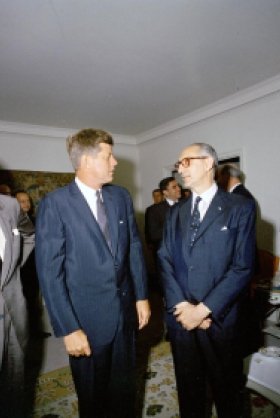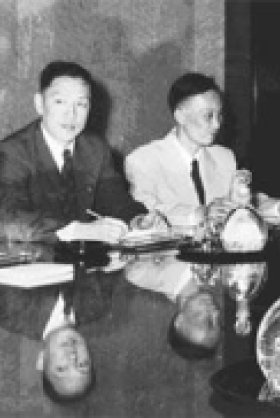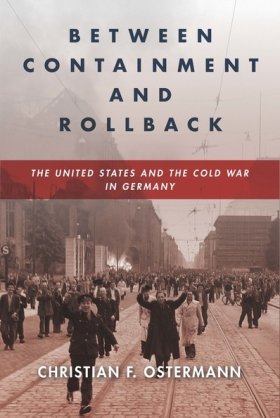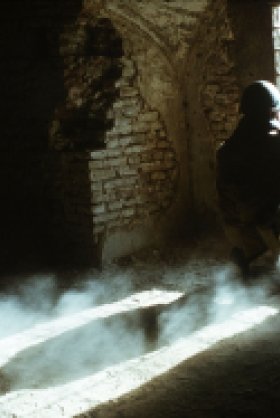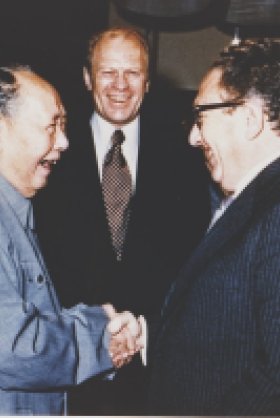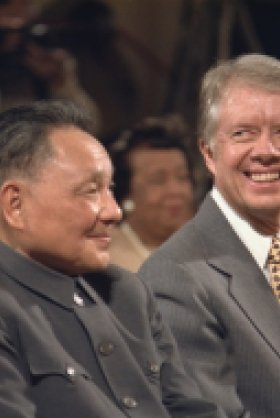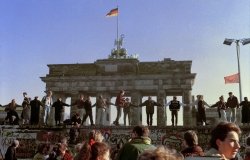Conference Report: "Western integration, German unification and the Cold War - The Adenauer Era in perspective
KONRAD ADENAUER AND THE COLD WAR
Twenty distinguished speakers from both sides of the Atlantic
gathered at Georgetown University on March 24/25 for a conference on
"Western Integration, German Unification, and the Cold War: The
Adenauer Era in Perspective," co-sponsored by the BMW Center for
German and European Studies at Georgetown and the German Historical
Institute. The first three panels reported on new research into the
attitudes toward German reunification of the four principal victors
of the Second World War plus the two German states. Jost Dülffer,
this year's Adenauer Professor at the BMW Center, opened with a
report on Adenauer's "Potsdam complex," i.e., his "nightmare" that
the four victors would reach agreement among themselves to create a
unified but neutral and weak Germany. To prevent this Adenauer sought
tenaciously to persuade all Western leaders that the Soviets posed
the greatest threat to liberty ever seen, and that Germany was the
crucial battleground in the Cold War. He also did his best to prevent
diplomatic conferences about Germany, because they would not accept
the Federal Republic as an equal partner. Dülffer questioned whether
the increase in tensions between East and West that resulted from
Adenauer's policy was necessary, or perhaps the harmful by-product of
a political strategy based on the deliberate cultivation of fear.
Adenauer's "Potsdam complex" seemed more and more puzzling as the
following papers were read. As Christian Ostermann reported, all U.S.
policy-makers came to agree with Adenauer by 1952/53 that a neutral,
reunified Germany would likely drift into the Soviet orbit; this
became their worst nightmare as well as his. As William Hitchcock
reported, the French concluded earliest and believed most strongly
that their national security required the enduring division of
Germany, even as they sought a close partnership with the West
Germans. In Great Britain, as we learned from Henning Hoff, Churchill
briefly considered talks over German reunification after the death of
Stalin. He soon dropped the idea, however, and Selwyn Lloyd argued
vigorously in a confidential memorandum in 1953 that "to unite
Germany while Europe is divided
is fraught with danger for all.
Therefore everyone-Dr. Adenauer, the Russians, the Americans, the
French and ourselves-feel in our hearts that a divided Germany is
safer for the time being." In view of this striking consensus, the
commentator Vojtech Mastny concluded that Adenauer's "Potsdam
complex" reflected a strange misunderstanding of the international
situation.
The most controversial position at the conference was taken in a
paper whose author, Wilfried Loth, unfortunately could not attend.
Loth has long maintained that Soviet foreign policy opened a window
of opportunity in 1952/53 for the reunification of Germany under
acceptably democratic conditions; his paper argued that two documents
recently made available to scholars from East European archives
substantiate this case. His interpretation of these documents
encountered massive criticism from Vojtech Mastny, however, who
declared that nobody outside Germany takes this question seriously
any longer. Several German participants expressed sympathy with
Loth's position but emphasized that the window of opportunity closed
quickly after the popular uprising in East Berlin in June 1953 and
the subsequent purge of Beria and Malenkov from the Soviet
leadership. Hope Harrison's presentation on East German foreign
policy undermined Loth's case, however, by showing that Khrushchev
later cited the foolish willingness of Beria and Malenkov to renounce
the support of eighteen million East Germans in exchange for nothing
as a prime reason for their purge. Harrison provoked some discussion
herself by comparing Adenauer with Walter Ulbricht as leaders who
felt that German reunification would undermine their own personal
power. Commentator Matthias Schulz noted that Adenauer did present a
coherent theory about national reunification: that a highly
prosperous and secure West Germany would exert an irresistible
"magnetic attraction" on East Germans. This theory achieved dramatic
successes until the East Germans built the Berlin Wall, and Schulz
argued that Adenauer could not have foreseen this development.
In the second half of the conference speakers addressed questions
about the domestic base of support for Adenauer's foreign policy, the
relationship between diplomacy and economics, and the role of
symbolism in international relations. Hans Mommsen delivered the
keynote address on the preconditions for the success of Adenauer's
"chancellor democracy." Mommsen emphasized that a very old pattern of
hostility toward any division of the German people into rival
political parties expressed itself in 1949 through widespread calls
for a "Great Coalition" between the CDU and SPD as the only
legitimate basis for the first government of the Federal Republic.
Adenauer campaigned successfully, however, to relegate the SPD to the
opposition. His manipulation of Cold War anxieties to polarize German
politics might offend the moralist, but it played a crucial role in
teaching the German people how parliamentary government functions. It
also served to weaken the splinter parties and promote the emergence
of a "two-and-a-half party system." Anja Kruke further explored
German politics by analyzing the growing reliance of politicians on
opinion polls. When Adenauer's foreign policy became most unpopular
in 1952, his top advisors learned from the polls to make "security"
the theme of all government pronouncements, security from the
Russians and from inflation and hardship. This over-arching theme
helped Adenauer to achieve a dramatic electoral victory in 1953.
Daniel Rogers then reported on the rigid opposition by the SPD to all
of Adenauer's major foreign policy initiatives, even when they
brought tangible gains. The Social Democrats long feared the re-
emergence of old-fashioned German nationalism and felt compelled to
don patriotic clothes that fit them poorly. Adenauer understood far
better that anti-communism was the only component of the old
nationalism to survive the Second World War with undiminished force.
Guido Thiemeyer explored the relationship between economics and
diplomacy by analyzing Ludwig Erhard's tenacious opposition within
the Adenauer cabinet to the creation of any "supra-national"
institutions to promote European economic integration. Erhard
insisted that the only path to integration was for all European
governments to accept voluntarily the rules of the free market and
sound public finance, and he regarded the creation of the Common
Market as a major defeat for liberal principles. William Gray
addressed the broader question of whether West Germany's "economic
miracle" tended to promote or delay progress toward German
reunification. Adenauer often encountered mistrust as his allies
pondered how West Germans might someday exploit their growing
economic power, but Gray argued that one must trace developments
through the late 1960s to understand the full range of foreign policy
benefits from economic growth. By 1968 the West Germans finally
achieved "parity" with the Western powers, in that their views on
trade and monetary policy carried great weight, and their prosperity
exerted such a powerful "gravitational attraction" that the Soviet
Union and other East Bloc governments scrambled for closer ties. Thus
the economic miracle created the foundations for the "Ostpolitik"
pursued thereafter by Willy Brandt.
The most imaginative papers at the conference involved cultural or
symbolic diplomacy. Simone Derix discussed the efforts by the West
German foreign office to orchestrate state visits to Berlin, focused
on highly emotional visits to the Wall, where the guest was expected
to offer some reaction for the press. After some visitors rebelled
against the official program, the foreign office later allowed them
to choose their own agenda. It then discovered that their spontaneous
gestures often proved more valuable for public relations than did the
old choreography. Martin Geyer offered a lively presentation on the
diplomacy of sports, one arena in which Adenauer suffered outright
defeat for his claim that the Federal Republic was the sole
international representative of the "German nation." Geyer suggested
that Germany finally entered the "post-national" era at the Munich
Olympics in 1972, when the East Germans secured recognition on West
German soil of their own flag and anthem to honor their numerous
medalists. In the final presentation, Johannes Paulmann discussed the
Brussels World's Fair of 1958, for which the architect Hans
Schwippert persuaded the West German government to offer a light-
hearted exhibition of German efforts to translate technological
progress into human welfare in everyday life. The center of the
pavilion was a collapsible canoe for vacationers, floating in a pond,
with the caption: "In Germany people play, like everywhere else."
Visitors greatly appreciated this novel attempt by Germans to display
self-restraint and a dedication to democratic values. Commentator
Roger Chickering noted that all three of these papers demonstrated
the great importance of "soft power" in international relations, but
also that the effects of cultural diplomacy are especially difficult
to predict and control.
To sum up the results of the conference, Jost Dülffer drew three
fundamental lessons: 1) that it took the Federal Republic a long time
to discover that it was a state, and even longer to discover that
there were two German states; 2) that Adenauer's theory of magnetic
attraction did succeed in reunifying Germany; and 3) that NATO's
strategy for the deterrence of Soviet aggression also succeeded.
Dülffer expressed abiding skepticism as to whether deterrence had
been necessary as well as successful, but he readily acknowledged
that others at the conference disagreed.
William Patch
Washington and Lee University
Related Program

Cold War International History Project
The Cold War International History Project supports the full and prompt release of historical materials by governments on all sides of the Cold War. Through an award winning Digital Archive, the Project allows scholars, journalists, students, and the interested public to reassess the Cold War and its many contemporary legacies. It is part of the Wilson Center's History and Public Policy Program. Read more
